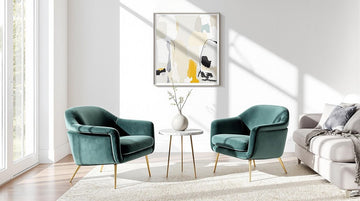Accent chairs do more than just give people a place to sit - they help make living rooms look and feel complete. When you choose and place them carefully, these special chairs can turn a basic room into a welcoming space that shows your taste while keeping everything looking neat and organized. The mix of different materials and smart placement helps people move naturally through the room. These chairs can either be the main focus of attention or add an interesting contrast to other furniture. There are some basic rules that help make accent chairs work well in any room's design.
Key Takeaways
Position accent chairs at complementary angles to your sofa, maintaining 18-24 inches of space for optimal traffic flow.
Select chairs approximately three-quarters the size of your main sofa to create visual harmony and proper proportions.
Mix textures and materials while keeping color schemes cohesive with existing furniture for a balanced, layered look.
Distribute multiple accent chairs evenly throughout the room to maintain symmetry and prevent visual crowding.
Choose chair styles that bridge your existing furniture pieces, balancing modern and traditional elements for unified design.
Choosing the Right Chair Style
When picking a chair for your living room, the style should work well with your current furniture while standing out in a good way. The goal is to find the right mix between old-fashioned and new styles, making sure your chair fits in with the room's look without taking over.
Think about how your room is styled. Old-fashioned chairs often have curved arms, button details in the fabric, and wooden legs with designs - perfect for classic rooms. New-style chairs have straight lines, simple shapes, and are made with modern materials like metal or clear plastic.
Finding the right mix of comfort and good looks is key when making your choice.
Look at how big the chair is compared to your room and other furniture. A tall chair with side wings can draw attention upward and become a room's centerpiece, while a small, armless chair works better in tight spaces.
The chair's shape should fit naturally with the room's style without being too big or bold. Look closely at the fabric feel, pattern size, and small details that can make a simple chair look special. For inspiration on making chairs the center of attention, explore statement armchairs as focal points.
Strategic Placement for Visual Impact
Where you put your accent chair can make a big difference in how your room looks and feels. Good placement helps create smooth movement through the room, draws attention to key spots, and keeps everything looking well-balanced.
There are several good ways to place your chair. Try setting it at an angle to your main couch or sofa to make a friendly spot for talking while keeping the room interesting.
You could also put it by a window to make a nice reading spot with plenty of daylight. In bigger rooms, use the chair to create a separate sitting area or to connect different parts of the room.
Think about how the chair works with main features like fireplaces, pictures, or special parts of the room. The chair can either work together with these features or become its own standout piece in a plain corner.
Make sure to leave enough space - about two feet - around the chair so people can walk easily while keeping the room looking good. For comprehensive guidance on furniture arrangement, check out lounge furniture arrangement for entertainment spaces.
Color and Pattern Coordination
Choosing the right colors and patterns for your accent chair helps create a well-put-together room design. The colors you pick can affect how a room feels - bright colors add energy while soft, neutral colors create a calm feeling. When mixing patterns, you need to think about their size and boldness to keep everything looking good together.
Keep these basic ideas in mind when picking colors and patterns:
Mix warm and cool colors by picking chairs that work well with your current colors while adding something new.
Use different-sized patterns together - big bold designs can work with smaller, quieter ones.
Look at the colors already in your room and decide if you want your chair to stand out or blend in.
Pick fabrics with different feels to add depth, even if you're using solid colors.
When mixing patterns, using the same colors but changing the pattern sizes usually works well. Whether you want a chair that grabs attention with bold prints or one that adds subtle detail, make sure your color and pattern choices fit with your room's overall look while making the space more interesting.
Scale and Proportion Basics
Scale and proportion are key design rules for choosing accent chairs for your living space. When picking accent chairs, think about how their size works with your other furniture and room size. Big chairs can make small rooms feel cramped, while small chairs might look too tiny in big rooms.
Important size factors include how tall, wide, and deep the chair is. The seat should be as high as your other chairs and sofas, usually between 17-19 inches for comfort and good looks. The chair's total height should match nearby furniture without blocking views or room features.
For good balance, your accent chair should work well with your main seating. A good rule is to pick accent chairs that are about three-quarters the size of your main sofa - this looks interesting but still fits together nicely.
Keep about 18-24 inches of space between furniture so people can walk around easily. When you use more than one accent chair, space them evenly from walls and other furniture to create a balanced look in your living room. For compact spaces, explore space-saving solutions for compact lounges.
Mixing Materials and Textures
Different materials and textures can make accent chairs more interesting in your living room. How you mix materials affects which parts of the room catch the eye first and where people tend to look. When picking accent chairs, think about how different surfaces can change both the look of your room and how it feels to touch.
Mixing materials can turn basic chairs into eye-catching pieces. Consider these basic texture and material combinations:
Soft velvet seats with metal legs create a nice contrast between smooth and hard surfaces
Leather and wood together give a classic, natural feel
Woven fabrics with glass or clear plastic parts look modern
Nubby bouclé fabric with brass details adds richness and draws attention
To mix materials well, aim for balance while adding different textures. Layer different surfaces carefully so each one fits your room's style.
Think about both looks and comfort when choosing materials, since textures affect how the chair feels as well as how it looks. For guidance on combining different upholstery types, read about mixing leather and fabric upholstery.
Conclusion
Adding accent chairs to your lounge can completely change how the space looks and feels. At Timbur, we craft unique accent chairs that blend seamlessly into any room design. The key is finding the right balance of style, size, and placement to create a welcoming atmosphere. By choosing complementary materials, patterns, and colors, your accent chairs can enhance the room's character while keeping it practical. When placed thoughtfully, these chairs not only provide comfortable seating but also serve as eye-catching design pieces that make your living space stand out.









